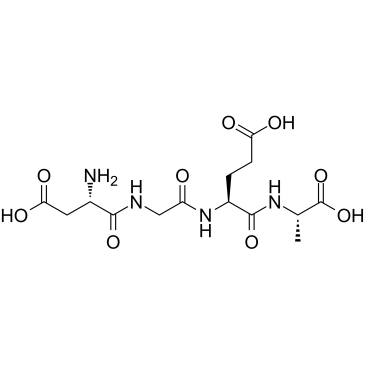α2β1 Integrin Recognition Sequence

α2β1 Integrin Recognition Sequence structure
|
Common Name | α2β1 Integrin Recognition Sequence | ||
|---|---|---|---|---|
| CAS Number | 134580-64-6 | Molecular Weight | 390.34600 | |
| Density | N/A | Boiling Point | N/A | |
| Molecular Formula | C14H22N4O9 | Melting Point | N/A | |
| MSDS | Chinese USA | Flash Point | N/A | |
|
Identification of a tetrapeptide recognition sequence for the alpha 2 beta 1 integrin in collagen.
J. Biol. Chem. 266 , 7363-7367, (1991) The alpha 2 beta 1 integrin serves as either a specific cell surface receptor for collagen or as both a collagen and laminin receptor depending upon the cell type. Recently we established that the alpha 2 beta 1 integrin binds to a site within the alpha 1 (I)... |
|
|
RGDS and DGEA-induced [Ca2+]i signalling in human dermal fibroblasts.
Biochim. Biophys. Acta Mol. Cell Res. 1746(1) , 28-37, (2005) A pulse of short peptides, RGDS and DGEA in the millimolar range, immediately elicits in normal human fibroblasts a transient increase of intracellular Ca2+ ([Ca2+]i). In the present study, we show that this [Ca2+]i occurs in an increasing number of cells as ... |
|
|
Glioma initiating cells form a differentiation niche via the induction of extracellular matrices and integrin αV.
PLoS ONE 8 , e59558, (2013) Glioma initiating cells (GICs) are considered responsible for the therapeutic resistance and recurrence of malignant glioma. To clarify the molecular mechanism of GIC maintenance/differentiation, we established GIC clones having the potential to differentiate... |
|
|
Enhancement of the Regenerative Potential of Anorganic Bovine Bone Graft Utilizing a Polyglutamate-Modified BMP2 Peptide with Improved Binding to Calcium-Containing Materials.
Tissue Eng. Part A 21 , 2426-36, (2015) Autogenous bone is the gold standard material for bone grafting in craniofacial and orthopedic regenerative medicine. However, due to complications associated with harvesting donor bone, clinicians often use commercial graft materials that may lose their oste... |
|
|
Nanofiber-based hydrogels with extracellular matrix-based synthetic peptides for the prevention of capsular opacification.
Exp. Eye Res. 143 , 60-7, (2015) Nanofiber-based hydrogels (nanogels) with different, covalently bound peptides were used as an extracellular environment for lens epithelial cells (LECs) in order to modulate the capsular opacification (CO) response after lens surgery in a porcine eye model. ... |